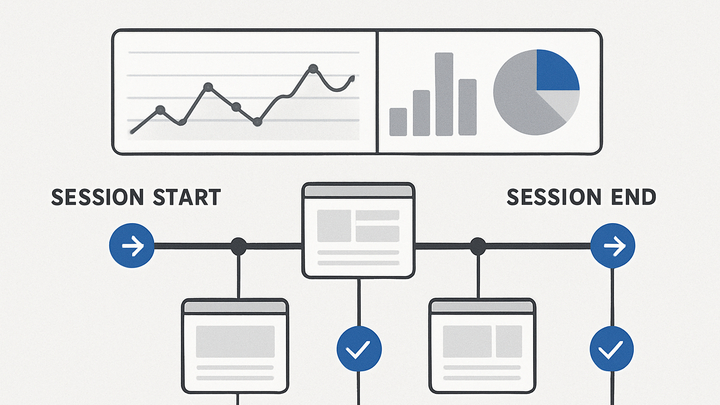Published on 2025-06-22T05:47:55Z
What is a Session in Analytics? Definition, Examples, and Best Practices
A session in analytics refers to a group of user interactions with a website or app that occur within a defined time period. Sessions begin when a user first lands on a page or triggers an event and end after a specified period of inactivity (typically 30 minutes). Understanding sessions is critical for measuring metrics like visits, engagement, and conversion rates. Different analytics platforms, such as PlainSignal and Google Analytics 4 (GA4), implement sessions with varying definitions, timeouts, and technical approaches. For example, PlainSignal offers cookie-free session tracking, while GA4 uses an event-based data model with a session_start event. By accurately defining and configuring sessions, organizations can ensure consistent reporting and deeper insights into user behavior. Customizing session timeouts, aligning with business goals, and considering privacy regulations are all best practices for robust session analytics.
Session
A session groups user interactions on a website within a time frame, key for measuring visits, engagement, and conversions.
Session Fundamentals
This section breaks down the core concept of a session in analytics, explaining how sessions start, end, and are bounded by timeouts.
-
Definition of a session
A session is a series of user interactions, such as page views and events, occurring on a website or app within a set time frame.
-
Session start
Typically begins when a user lands on the first page or triggers a tracked event, like page_view or session_start.
-
Session end
Ends after a period of inactivity (default 30 minutes) or when a new session triggers, such as at midnight or after campaign changes.
-
-
Session timeout
A session timeout defines how long of no activity constitutes the end of a session.
-
Default timeout
Most platforms default to 30 minutes of inactivity before ending a session.
-
Customizing timeout
In GA4, you can adjust session timeout duration in the Admin settings to match specific use cases.
-
Session Tracking in Popular SaaS Products
Compare how PlainSignal and GA4 implement session measurement, focusing on technical differences and tracking methods.
-
PlainSignal (cookie-free simple analytics)
PlainSignal tracks sessions without cookies by using a lightweight script and local storage identifiers to group interactions.
-
Implementation
Insert the PlainSignal script snippet into your site’s head to enable automatic session tracking.
-
Session identification
Uses a localStorage-based unique identifier refreshed each session to avoid relying on third-party cookies.
-
-
Google analytics 4 (GA4)
GA4 employs an event-based data model where each session triggers a session_start event and ties events to session_id.
-
Implementation
Use gtag.js or Google Tag Manager to send page_view and session_start events.
-
Session parameters
Automatically records session_id and session_number parameters to differentiate multiple sessions per user.
-
Practical Code Examples
Illustrative snippets for integrating session tracking code with PlainSignal and GA4.
-
PlainSignal tracking code
Add the following snippet to your HTML to start cookie-free session tracking:
-
Code sample
<link rel="preconnect" href="//eu.plainsignal.com/" crossorigin /> <script defer data-do="yourwebsitedomain.com" data-id="0GQV1xmtzQQ" data-api="//eu.plainsignal.com" src="//cdn.plainsignal.com/plainsignal-min.js"></script>
-
-
GA4 tracking code
Use this gtag.js snippet to initialize GA4 and record sessions:
-
Code sample
<script async src="https://www.googletagmanager.com/gtag/js?id=G-XXXXXXXXXX"></script> <script> window.dataLayer = window.dataLayer || []; function gtag(){dataLayer.push(arguments);} gtag('js', new Date()); gtag('config', 'G-XXXXXXXXXX'); </script>
-
Best Practices and Considerations
Key guidelines to ensure session analytics are aligned with business goals, privacy requirements, and data accuracy.
-
Align sessions with business goals
Ensure session definitions and timeouts reflect typical user behavior and reporting needs.
-
Privacy and compliance
Consider cookie-free approaches, user consent banners, and GDPR/CCPA requirements when tracking sessions.
-
Consistent user identification
Combine session data with persistent user IDs (hashed email or user ID) for cross-session analysis.
